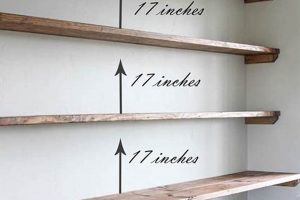Modular block systems offer a viable solution for constructing earth retention structures on residential properties. These systems, often utilizing interlocking concrete units, allow homeowners to undertake projects that would traditionally require professional engineering and construction services. The pre-engineered nature of the blocks simplifies the design and installation process, making stable and aesthetically pleasing walls achievable for those with basic construction skills and a willingness to follow manufacturer guidelines.
The appeal lies in cost-effectiveness and the satisfaction of completing a significant landscaping project independently. Compared to poured concrete walls or timber retaining systems, modular block construction can often reduce material costs and eliminate the need for specialized equipment. Historically, retaining walls were the domain of skilled laborers. The advent of user-friendly block systems empowers individuals to manage erosion control and enhance property value with their own labor and resourcefulness.
The following sections will delve into the considerations for planning, preparing the site, installing the base, and laying the blocks to ensure a durable and structurally sound retaining wall. This includes addressing crucial aspects like drainage, backfilling, and adhering to local building codes.
Installation Tips for Modular Block Retaining Walls
The successful construction of a modular block retaining wall hinges on meticulous planning and execution. Adherence to best practices throughout the projects lifespan is crucial for ensuring its structural integrity and longevity.
Tip 1: Consult Local Building Codes: Prior to commencing any work, research and comply with all applicable municipal and regional building codes. This includes acquiring necessary permits and understanding regulations regarding wall height, setback requirements, and drainage specifications. Failure to do so may result in fines or the need to dismantle and rebuild the structure.
Tip 2: Ensure Proper Drainage: Implement a comprehensive drainage system behind the wall to prevent hydrostatic pressure buildup. This generally involves installing a perforated drain pipe at the base of the wall, encased in gravel, and incorporating a filter fabric to prevent soil particles from clogging the system. Effective drainage is paramount for preventing wall failure over time.
Tip 3: Level the Base Course Meticulously: The foundation of the wall is arguably the most critical element. Ensure the base course is perfectly level across its entire length and width. Variations in level will compound as subsequent courses are laid, leading to an unstable and visually unappealing structure. Use a laser level or transit level to guarantee accuracy.
Tip 4: Use Granular Backfill Material: Select a well-draining granular backfill material, such as crushed stone or gravel, to place behind the blocks. Avoid using native soil, as it often contains organic matter and clay, which can retain water and exert undue pressure on the wall. Compact the backfill in layers to ensure stability and prevent settling.
Tip 5: Consider Geogrid Reinforcement: For walls exceeding a certain height or subject to significant lateral pressure, incorporate geogrid reinforcement into the backfill. Geogrid is a high-strength polymer grid that extends horizontally into the soil, creating a reinforced soil mass that resists the forces acting on the wall. Consult with a qualified engineer to determine the appropriate geogrid specifications.
Tip 6: Offset Each Course: Stagger the joints between each course of blocks. This provides additional strength and prevents continuous vertical seams that can weaken the wall. Typically, a half-block offset is sufficient.
Tip 7: Compact Backfill in Lifts: After each course of blocks is laid, add and compact the backfill in thin lifts (layers). This prevents excessive pressure against the blocks during compaction and helps ensure even distribution of the load.
By adhering to these guidelines, individuals can significantly increase the likelihood of constructing a robust and aesthetically pleasing retaining wall. Remember that meticulous attention to detail and a thorough understanding of basic construction principles are essential for success.
The following sections will present potential challenges and offer solutions for addressing common issues encountered during modular block retaining wall projects.
1. Gravity Retaining Structures
Gravity retaining structures represent a fundamental engineering approach to managing soil retention. Their design relies primarily on the weight of the structure itself to counteract the lateral pressure exerted by the retained soil. Within the context of modular block wall projects, including do-it-yourself installations, understanding the principles of gravity wall design is essential for ensuring stability and preventing potential failure.
- Mass and Stability
The defining characteristic of a gravity retaining structure is its substantial mass. This mass directly opposes the forces tending to overturn or slide the wall. In the context of modular block walls, each block contributes to the overall weight, and the cumulative weight of the structure provides resistance against soil pressure. The size and depth of the blocks are determined, in part, by the height of the retained soil and its density, influencing the overall stability.
- Internal Friction and Interlock
While mass is the primary factor, the internal friction between the blocks and the interlock mechanisms contribute significantly to the structure’s stability. Interlock systems, such as lips, pins, or overlapping designs, create a shear resistance that prevents individual blocks from sliding relative to each other. This integrated system effectively distributes the lateral load across the wall’s entire surface, rather than concentrating it on individual blocks.
- Base Friction and Soil Interaction
The friction between the base course of the retaining wall and the underlying soil foundation is a critical component of its overall stability. A properly prepared and compacted base provides a high friction coefficient, preventing the wall from sliding forward due to lateral earth pressure. The selection of appropriate base materials, such as compacted gravel or crushed stone, directly influences the frictional resistance and the long-term stability of the structure.
- Limitations and Reinforcement
Gravity retaining structures, while effective for moderate heights, have inherent limitations. As wall height increases, the required mass to maintain stability also increases significantly, potentially becoming impractical or uneconomical. In such cases, additional reinforcement techniques, such as geogrid reinforcement, are often employed to extend the height capabilities of modular block walls while maintaining stability. Geogrid extends into the soil mass behind the wall, creating a composite structure that resists lateral forces.
Modular block walls, including those undertaken as DIY projects, leverage the principles of gravity retaining structures to provide effective soil retention. However, understanding the limitations and incorporating appropriate design considerations, such as base preparation, interlock mechanisms, and reinforcement when necessary, are crucial for ensuring the long-term performance and safety of the structure. Ignoring these principles can lead to instability, wall failure, and potential property damage.
2. Modular block installation
Modular block installation constitutes a core element in the successful construction of a retaining wall utilizing systems such as Redi-Rock. The Redi-Rock DIY retaining wall concept hinges on the ease and efficiency with which these pre-cast concrete blocks can be assembled on-site. Incorrect installation can compromise the wall’s structural integrity, leading to potential collapse or premature failure. For instance, if the base course is not properly leveled during modular block installation, subsequent courses will be misaligned, creating stress points and weakening the overall structure. The proper execution of modular block installation is, therefore, not merely a procedural step but a crucial determinant of the wall’s long-term performance.
Beyond the foundational importance of a level base, other aspects of modular block installation, such as proper interlock, backfilling, and drainage integration, directly affect the wall’s stability. Many modular block systems, including Redi-Rock, employ interlocking mechanisms to enhance shear resistance and prevent individual blocks from shifting. However, these mechanisms only function as intended if the blocks are installed correctly. Similarly, proper backfilling practices, involving the use of granular materials and compaction in lifts, are essential for distributing loads evenly and preventing hydrostatic pressure buildup. The neglect of any of these installation aspects compromises the functionality of the wall. A retaining wall along a highway, for example, that does not properly integrate drainage due to faulty modular block installation may experience water saturation behind the wall, increasing the risk of failure during freeze-thaw cycles.
In summary, modular block installation is not a standalone task but an integrated process within the larger context of retaining wall construction. Its proper execution, encompassing leveling, interlock, backfilling, and drainage, is fundamental to the stability and longevity of the wall. The Redi-Rock DIY approach depends heavily on the user’s understanding and competence in these installation techniques. Recognizing the challenges associated with ensuring correct installation, manufacturers typically provide detailed guidelines and training resources. Adhering to these recommendations is paramount for achieving a structurally sound and aesthetically pleasing retaining wall.
3. Site grading & leveling
The processes of site grading and leveling are fundamental prerequisites for any successful construction project, and especially crucial in the context of a “redi-rock diy retaining wall”. These activities ensure a stable, well-drained foundation for the wall, directly impacting its structural integrity and longevity.
- Foundation Stability
Proper site grading establishes a level surface or a gently sloping grade that allows the base course of the Redi-Rock wall to be laid evenly. Uneven ground can lead to differential settling, which can cause cracks, instability, and eventual failure of the retaining wall. In a residential setting, if a homeowner attempts to build a Redi-Rock wall on a steeply sloped, unprepared site, the resulting wall may lean or collapse under the pressure of the retained soil.
- Drainage Control
Site grading plays a pivotal role in managing surface water runoff. By establishing positive drainage away from the wall, the accumulation of water behind the structure is minimized. Excess water pressure is a primary cause of retaining wall failure. For example, a properly graded site would direct rainwater away from the back of the Redi-Rock wall, channeling it into designated drainage pathways or a stormwater management system.
- Soil Compaction and Bearing Capacity
The process of leveling often involves soil compaction, which increases the soil’s density and bearing capacity. This is essential for supporting the weight of the Redi-Rock blocks and the retained soil. Inadequate compaction can result in the soil settling over time, leading to movement and instability in the wall. Consider a situation where a DIY installer skips the compaction step; the Redi-Rock wall could gradually sink or tilt as the underlying soil compresses under the load.
- Erosion Prevention
Effective site grading minimizes erosion around the base of the retaining wall. By controlling the flow of water and stabilizing the soil surface, the risk of undermining the foundation is reduced. Undermining can compromise the wall’s structural integrity and necessitate costly repairs. If a Redi-Rock wall is built on a site prone to erosion, the surrounding soil could be washed away during heavy rainfall, eventually leading to the wall’s collapse.
In conclusion, site grading and leveling are not merely preparatory steps but integral components of a successful “redi-rock diy retaining wall” project. These processes ensure a stable foundation, effective drainage, adequate soil support, and erosion prevention, all of which contribute to the wall’s long-term stability and functionality. Neglecting these crucial aspects can lead to structural problems, increased maintenance costs, and potentially catastrophic failure of the retaining wall.
4. Geogrid reinforcement layers
The connection between geogrid reinforcement layers and a Redi-Rock DIY retaining wall lies in the increased structural stability afforded to the wall, particularly as height and load demands increase. Geogrid serves as a soil reinforcement material, extending horizontally into the backfill behind the wall and creating a composite structure that resists lateral earth pressure. The cause-and-effect relationship is direct: the inclusion of geogrid significantly enhances the wall’s capacity to withstand the forces exerted by the retained soil. For instance, a Redi-Rock wall exceeding four feet in height or supporting a heavy surcharge load (e.g., a driveway) would likely necessitate geogrid to prevent overturning or sliding. Without geogrid, such a wall would be vulnerable to failure due to excessive lateral pressure.
The importance of geogrid as a component of a Redi-Rock DIY retaining wall stems from its ability to distribute the load over a larger area and engage a greater volume of soil to resist lateral forces. This is achieved by the geogrid’s interlocking with the compacted backfill, creating a reinforced soil mass. In practical terms, the geogrid layers act as tensile elements within the soil, preventing it from shearing or deforming under pressure. This system is especially relevant in areas with unstable soil conditions or high seismic activity, where the wall is subjected to increased stress. The practical significance of this understanding lies in ensuring the long-term durability and safety of the retaining wall. Choosing the appropriate type and length of geogrid, as well as proper installation techniques, are crucial considerations.
In summary, geogrid reinforcement layers are a critical component of Redi-Rock DIY retaining walls when specific design parameters necessitate increased stability. While smaller walls may rely solely on the mass of the blocks, taller walls or those supporting significant loads depend on the composite structure created by geogrid to resist lateral earth pressure. The challenge lies in accurately assessing the soil conditions, wall height, and surcharge loads to determine the appropriate geogrid specifications. Understanding the principles of soil reinforcement and adhering to manufacturer guidelines are essential for a safe and effective Redi-Rock DIY retaining wall installation.
5. Permeable backfill drainage
The correlation between permeable backfill drainage and a Redi-Rock DIY retaining wall lies in the mitigation of hydrostatic pressure. The fundamental cause of many retaining wall failures is the buildup of water pressure behind the wall, which exerts significant lateral force. Permeable backfill, consisting of materials like gravel or crushed stone, allows water to flow freely and drain away from the wall, preventing this pressure buildup. Without adequate drainage, water accumulates, saturating the soil and increasing its weight, thus amplifying the lateral force against the wall. For example, imagine a Redi-Rock wall constructed without proper backfill drainage in an area with heavy rainfall. The saturated soil would exert immense pressure, potentially causing the wall to bow, crack, or even collapse. The practical significance of understanding this relationship lies in ensuring the wall’s long-term stability and preventing costly repairs.
The construction of permeable backfill drainage typically involves incorporating a perforated drain pipe at the base of the wall, surrounded by gravel or crushed stone. This drain pipe directs water away from the wall’s foundation. The selection of appropriate backfill material is crucial; materials with a high clay content are unsuitable as they impede drainage. A filter fabric is often used to separate the backfill from the native soil, preventing soil particles from clogging the drainage system. The location and design of the drainage system should be tailored to the specific site conditions and the anticipated amount of rainfall. Incorrect installation of the drainage system can render it ineffective, leading to water accumulation and potential wall failure. The permeable backfill, combined with a properly functioning drainage system, ensures that water is efficiently removed, reducing the risk of hydrostatic pressure.
In summary, permeable backfill drainage is an indispensable component of a Redi-Rock DIY retaining wall, particularly in areas with significant rainfall or high water tables. The system’s function is to prevent hydrostatic pressure buildup, which can compromise the wall’s structural integrity. While the Redi-Rock system itself provides a robust structure, its effectiveness is contingent upon the implementation of a properly designed and installed drainage system. The challenge lies in accurately assessing the site’s drainage needs and selecting appropriate materials and installation techniques to ensure the long-term performance and stability of the retaining wall. Improper drainage represents a critical oversight that can negate the benefits of using a modular block system like Redi-Rock.
Frequently Asked Questions About Redi-Rock DIY Retaining Walls
The following section addresses common inquiries and misconceptions regarding the planning, design, and construction of Redi-Rock retaining walls undertaken as do-it-yourself projects. This information aims to provide clarity and guidance for individuals considering this type of project.
Question 1: Is engineering expertise required for Redi-Rock DIY retaining wall projects?
While Redi-Rock blocks are designed for relatively straightforward installation, engineering oversight is advisable for walls exceeding a certain height or subject to significant surcharge loads. Local building codes often mandate engineering review for walls above a specified height. The absence of professional engineering can lead to structural instability and potential failure.
Question 2: What are the primary considerations for site preparation before installing a Redi-Rock wall?
Proper site preparation is paramount. This includes accurate grading and leveling to establish a stable base, ensuring adequate soil compaction to support the wall’s weight, and implementing effective drainage solutions to prevent hydrostatic pressure buildup. Failure to adequately prepare the site can compromise the wall’s long-term stability.
Question 3: How is proper drainage achieved behind a Redi-Rock retaining wall?
Effective drainage is achieved through the use of permeable backfill materials, such as gravel or crushed stone, and the installation of a perforated drain pipe at the base of the wall. Filter fabric is often employed to prevent soil particles from clogging the drainage system. Proper drainage prevents water accumulation and reduces the risk of wall failure due to hydrostatic pressure.
Question 4: What role does geogrid reinforcement play in Redi-Rock retaining wall construction?
Geogrid reinforcement is used to enhance the stability of taller walls or walls subject to significant lateral loads. The geogrid extends into the soil mass behind the wall, creating a composite structure that resists overturning and sliding. Proper selection and installation of geogrid are crucial for its effectiveness.
Question 5: What are the common mistakes to avoid when building a Redi-Rock DIY retaining wall?
Common mistakes include inadequate site preparation, improper drainage installation, failure to adhere to building codes, neglecting geogrid reinforcement when necessary, and using unsuitable backfill materials. Avoiding these errors is essential for ensuring the wall’s structural integrity and longevity.
Question 6: How are local building codes and permit requirements addressed for Redi-Rock DIY retaining wall projects?
It is imperative to research and comply with all applicable local building codes and permit requirements. This may involve submitting construction plans for review and obtaining necessary permits before commencing work. Failure to comply with local regulations can result in fines, stop-work orders, or the need to dismantle and rebuild the wall.
Successfully constructing a Redi-Rock retaining wall as a DIY project requires careful planning, attention to detail, and adherence to established best practices. Understanding these key considerations is crucial for achieving a durable and aesthetically pleasing structure.
The following section will provide additional resources and references for further exploration of Redi-Rock DIY retaining wall construction.
redi-rock diy retaining wall
This exploration has underscored the multifaceted nature of undertaking a Redi-Rock retaining wall project as a do-it-yourself endeavor. Key aspects, including proper site preparation, drainage considerations, the potential need for geogrid reinforcement, and adherence to local building codes, have been identified as critical determinants of the structure’s stability and longevity. The gravity-based design of the Redi-Rock system offers a viable solution for earth retention, but its effectiveness is contingent upon meticulous execution and a thorough understanding of foundational engineering principles.
Ultimately, the success of a Redi-Rock DIY retaining wall rests on the responsible application of knowledge and diligent adherence to best practices. Prospective builders are urged to prioritize thorough research, seek professional guidance when necessary, and meticulously follow manufacturer recommendations. The stability and safety of the structure, and potentially the surrounding property, depend on informed decision-making and unwavering attention to detail.







